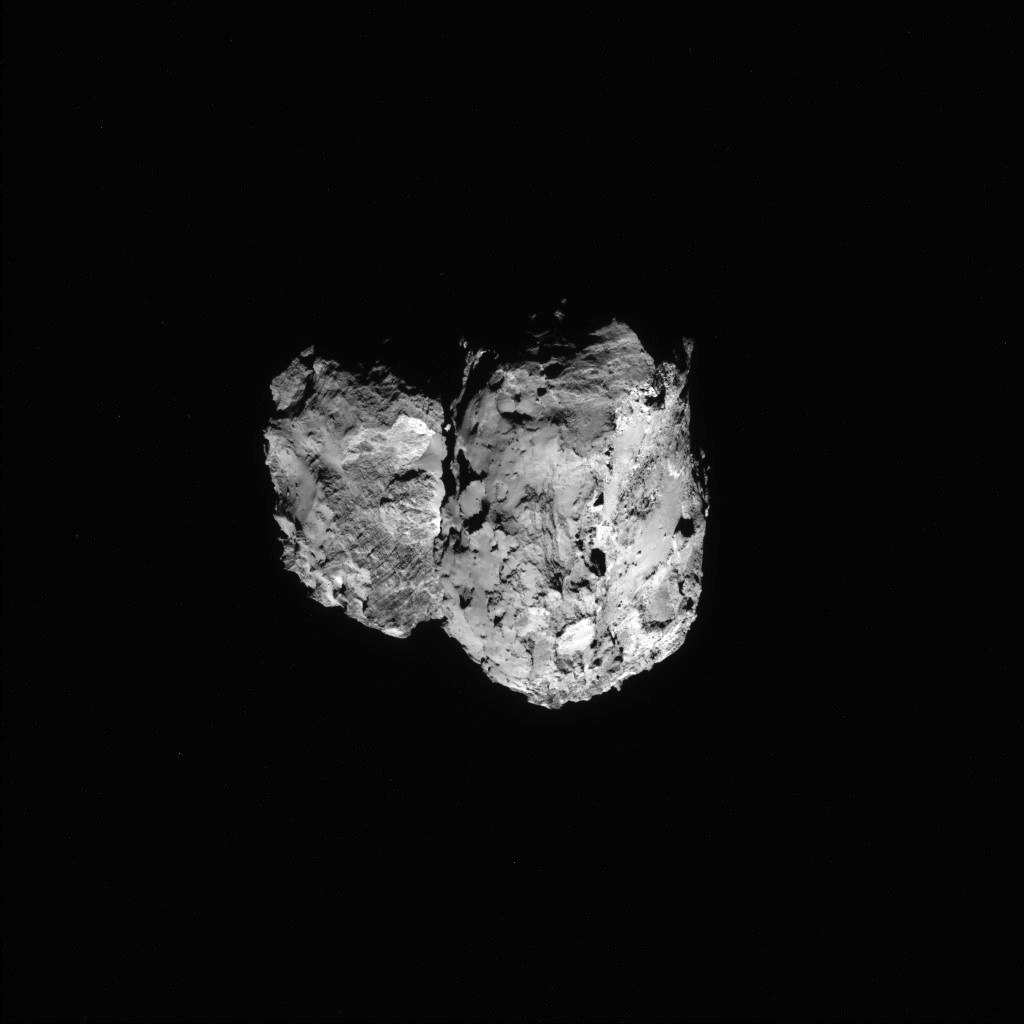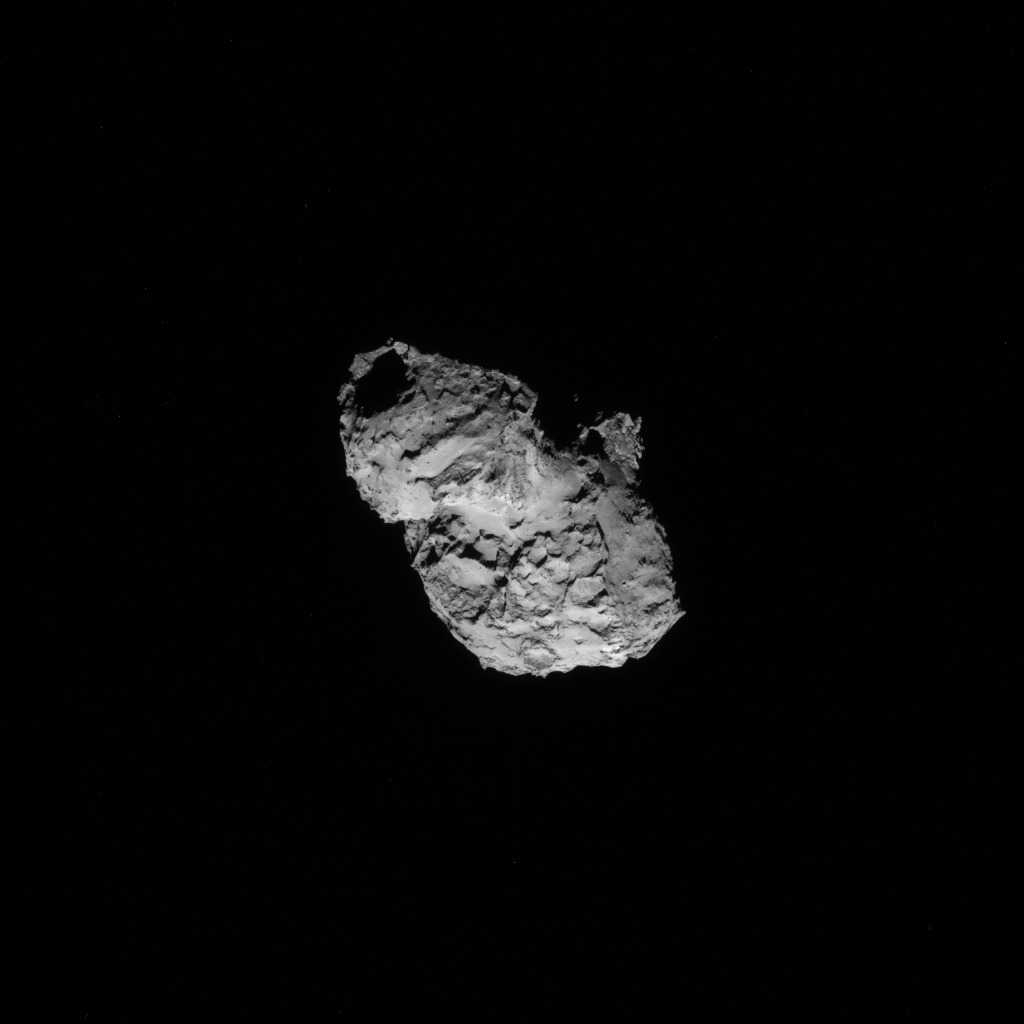The daily navigation camera (NAVCAM) images continue, and now that Rosetta is so close to comet 67P/C-G, the nucleus is very well visible in the full-frame images from 5 and 6 August 2014.
NAVCAM image from 6 August, taken at about 96 km from the comet.
View and download the image here.

Full-frame NAVCAM image taken on 6 August 2014 from a distance of about 96 km from comet 67P/Churyumov-Gerasimenko. Credits: ESA/Rosetta/NAVCAM
And a catch-up from 5 August too: NAVCAM image taken at about 145 km from 67P/C-G.
View and download the image here.










Discussion: 29 comments
This is really getting exciting, the surface is supposed to be fairly soft by all accounts, on today’s thinking that is. So looking at the outer rim of some of the impact craters, the velocity at impact must have been extraordinary slow depending on the size of the object.
Unless the craters are not caused by impact, of course. Observations have shown that the comet nucleus is not soft, or a dirty snowball. Little or no surface ice has ever been seen on the five previously visited comets. Furthermore, the Deep Impact mission resulted in a sharp increase in x-rays following the collision, providing evidence that the comet is actually very hard. I believe the comet is a dry rock being eroded from the outside via discharge by its interaction with the solar wind.
great job!
Congratulations Rosetta, ESOC and ESA… now the bulk of the science can get underway after the flawless arrival. Thankyou for keeping the images coming so we peeps can keep along for the ride, much appreciated.
I can’t help but notice on the image from the 6th that there is a large “straight” area with parallel lineations all along it (over on the left side)… very intriguing, as is the whole surface!!
Bravo.
What kind of exposure times is Navcam using? The comet is blacker than coal, and is further out from the sun than Mars, so I would expect quite long exposure times in order to collect enough light. Yet, stars are very faint in the background. Sure, I’m assuming that the sensor array is not your ordinary DSLR, but if that means it’s more sensitive, all the more reason to see more stars, no?
Same question here. How do Rosetta cameras work? ISO? Exposure time? Aperture?
OK great pictures but being someone who has just been swept along with all this and no knowledge of comets before this last few months of watching Rosetta. I bet this is a real dumb question but if the ice and dust is melting off at a rate why can I see craters why are they and the whole thing no smooth. Someone had to ask.
Because it is in vacuum, the water ice cannot “melt” but sublimates, changing directly from solid to gas. This might prevent erosion of surface features. Living in Canada, I’ve seen my fair share of melting snow banks. They form some fantastical shapes because the accumulation of dirt can accelerate melting in one area exposed to the sun while insulating other areas.
Hello,
67P is a young comet.
Originally it was a body with nearest solar
distance about 4.0 AU:
Around 1840 it came near to Jupiter
which changed the orbit. It got nearer
to sun, at 2.7 AU. 1959 it had another
“visit” near Jupiter, changing the trajectory
again. Now it comes until 1.3 AU.
So far, it had only 9 “hot” passages (at
about 1.3 AU), 2015 will become
number 10.
Most changes in surface happen(ed)
at these few hot passages.
Ingo.
My guess is that the craters are not due to impacts, but rather explosions from below. This could happen with rapid volatilization of icy material as the comet warms.
CONGRATULATIONS!!! This is a fabulous outcome at this point of Rosetta’s journey….Bravo/Brava to the ESA team!
Watching the video taken by NAVCAM aboard Rosetta as it nears the comet, the strange wobbling tumble of Chury through space will make establishing an orbit about it extremely difficult let alone attempting to deploy the module. Such finite instructions required to first align Rosetta with Chury’s axis of rotation before assuming orbit, than begin an orbit which will eventually align with the proposed touchdown site, then finally tightening the orbit around Chury to deploy the module, will be quite complex and will require exact timing for all to go as planned. What is the proposed timeframe for all of the finite movements Rosetta must make before deployment? Has any of the proposed plans changed since arrival at the comet?
It’s not obvious we’ve seen any impact craters yet. The pits and circular features may well result from outgassing events. That aside, it’d be nice if the big hole on the duck’s head contained a chunk of stoney impactor. That’d explain how the center of gravity can be in the neck.
Incredible images. IMHO, I think most the craters are not impact sites but rather subsidence, sinkholes, collapse of caverns that are produced from the expulsion of volatiles. The large crater on the ducks head should have fractured the smaller lobe (head). This must be a debate brewing among the scientists. Impacts or sinkholes/subsidence?
The usual description ‘dirty snowball’ will not be so readily trotted out for comets in the future.
I don’t think those are all impact craters. I’m thinking they are most likely erosion sites cause by out gassing of underlying volatile material. They could possible start out as smaller impart sites, but the walls then are eroded back over time.
Lots of
single orientation
layers on the head of the duck.
https://blogs.esa.int/rosetta/files/2014/08/ROSETTA_NAVCAM_20140806_2.jpg
Is the missing part of the duck head
near the neck?
What if
the Oort Cloud
was not more than
the cold cold space
between heliopauses?
If so,
then Oort Cloud comets
could be
some kind of chemical samples
of the galaxy “weather”.
We need
more Rosettas
right now!
🙂
Cooperation is much healthier and beneficial compared to ruthless competition. Thank you ESA for stimulating our imaginations with this fine example of what our leaders can accomplish by working side by side with other nations. We wish you heartfelt success with this brilliant spacecraft Rosetta.
It seems that the duck’s (chicken’s) neck will evaporate.
I’m not even close to an expert in space travelling, physics or even science in general. But seeing these images, watching your live coverage and science explanations for us dummies made me shiver in awe for several reasons. Probably I dont even start to understand the complexity of this mission, still you’ve made it this far, which is so brilliant. And only now, as I understand, the fun part begins! Even I got a ton of questions watching all this stuff, how much more excited must you guys be right now with all your experiments only starting now, all the best of luck with it!
And then there is the organizational/political part of it. Guys, making this happen as a multi-national effort makes me jump in excitement. Stuff like this is what brings us all together as the humans we all are. We should have many, many more of these projects as coorperations all over the globe and there might be a true chance to leave behind all those small national bordered thinking for good in some not so distant future. We may all pull together one day as mankind, you’ve just given the very best of examples for us all of how to do it with style. Even more thanks for that.
This is an historical achievement, in the name of peace and future for mankind I bow in admiration and thankfulness!
I’m affraid Rosetta is lost…
Thank you so much for this very special birthdaygift on August 6th and congratulation to ESA for this success .
I’m more than lucky to know that Rosetta is alive. ESA was not releasing new images which, for me, was an indication that something went wrong. I’m really happy to know I was wrong.
She is taking a sunbath.
Just for cleansing .)
This photo:
https://blogs.esa.int/rosetta/files/2014/08/ROSETTA_NAVCAM_20140805.jpg
Shows a common pattern of orientation
(up and left) in the sublimation craters.
Maybe from the last perihelion.
Here is my landing view for Philae.
Approximating from bottom right
to up left.
https://blogs.esa.int/rosetta/files/2014/08/ROSETTA_NAVCAM_20140805.jpg